From Le Signal to Les Prés
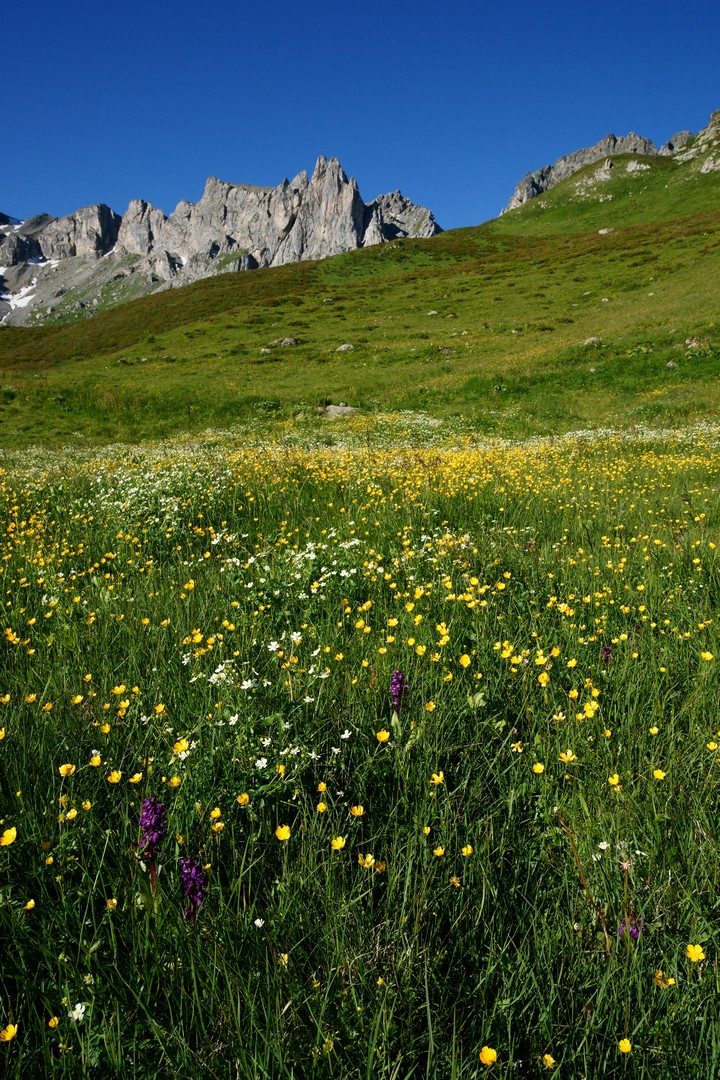
Les Contamines-Montjoie
From Le Signal to Les Prés
Medium
5h
12km
+698m
-698m
Embed this item to access it offline
Attachment
- Downloadpdf
les-pres-depuis-le-signal
Credit: Points d'intérêts du parcours - Asters-CEN74
9 points of interest
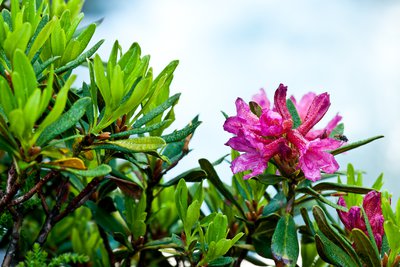
Rhododendron ferrugineux - Julien Heuret - CEN 74  Flora
FloraThe Rusty-leaved Alpenrose
It owes its name to the rust-coloured underside of its leaves! This plant belongs to the Ericaceae family, which includes bilberries and heathers. It blooms from the end of June, attracting many pollinating insects. It is a fan of chilly locations: it tends to grow on the north-facing slopes where sun exposure is shortest. The reason for this is that it doesn't shed its leaves in winter, so it needs a thick blanket of snow to keep it from freezing!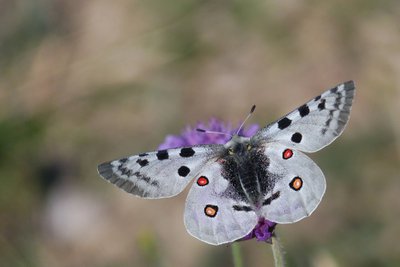
Grand apollon - Benoit Maubé - CEN 74  Fauna
FaunaAs handsome as Apollo
This butterfly is a Rhopalocera, i.e. a common butterfly. It can be found in the mountains, in open environments with a certain amount of vegetation, its caterpillar tending to prefer orpins or houseleeks, while as an adult it feasts on the nectar of thistles and other knapweeds. It's beautiful... like a deity, but please just look at it, because it's an endangered species, protected both in France and worldwide!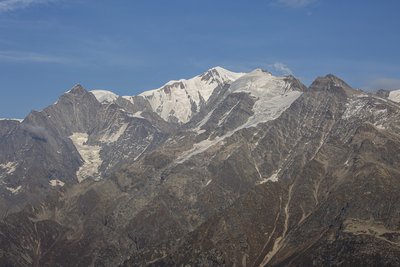
Panorama du massif du Mont Blanc - Geoffrey Garcel - CEN 74  Panorama
PanoramaMont-Blanc massif panorama
From here, you can see Mont-Blanc, the highest peak in Europe (4810 m), absolutely towering over the whole massif! Admire the view of the other peaks: the Aiguille de Bionassay (4052 m), the Dômes de Miage (3633 m) and the Aiguille Nord de Tré la Tête (3892 m), the highest point in the nature reserve. From this point, you can marvel at one of the parts of the reserve, which features various protected natural environments, situated in an area with over 2800m of variating altitude starting at the forest level.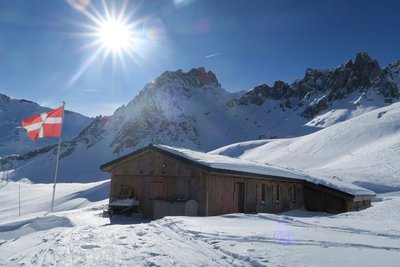
@GeoffreyGarcel 
Les Pres Refuge
The new Les Prés Refuge was built at an altitude of 1935m at the foot of the Aiguille de la Cicle (2552m), ideally situated in the heart of the nature reserve and right next to the hiking trails. This former mountain pasture farmhouse was restored in 2020 at the initiative of the Compagnie des Guides de Saint-Gervais-Contamines. This refuge is one of the few to be manned for more than 7 months of the year, including winter.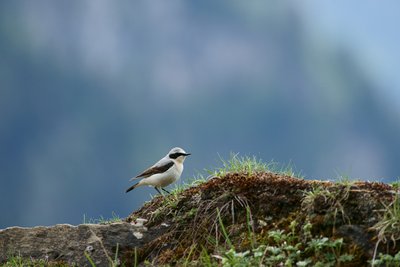
Mâle Traquet motteux - Julien Heuret - CEN 74  Fauna
FaunaThe Northern Wheatear
Have you seen Zorro with his black blindfold?! The male Northern Wheatear is a sparrow-sized passerine bird. However, this 25g lightweight is a long-distance migrant. Although it comes to nest in the mountains in summer, in search of insects such as flies, locusts and other grasshoppers, which are abundant in the alpine meadows, it spends the winter much further south, in the savannahs of tropical Africa, from Mauritania to Tanzania!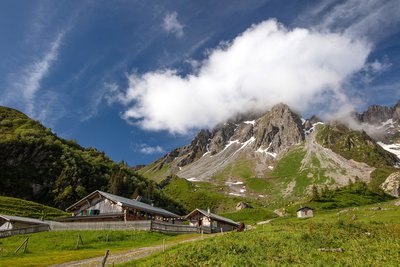
Geoffrey Garcel - CEN 74  Refuge
RefugeThe mountain refuge of la Balme
Situated at the foot of the Aiguilles de la Pennaz (2668 m) as part of the Mont-Blanc tour, this refuge has a strong heritage of family tradition. Three generations have welcomed hikers here. This former farmhouse is surrounded by mountain pastures that are still cultivated by mountain farmers. Just look at the height of the roof and little will be left to imagination; during winter, the only thing sticking out of the snow is the chimney! This refuge is open from June to September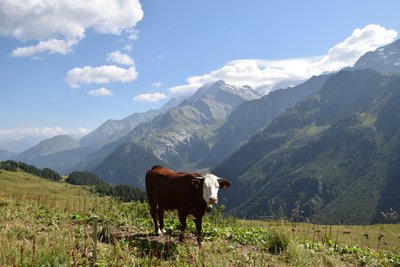
Vache de race Abondance - Geoffrey Garcel - CEN 74 
Cow mountains
How can you tell which breeds of mountain cow can be found here? The Abondance breed originates from the village of the same name in the Chablais region of Haute-Savoie. It can be recognised by its distinctive mahogany coat and white head and belly. The 'Herens' cow comes from Valais in Switzerland. They are bulkier, with a single-coloured coat that is often black, sometimes dark red or chestnut. Its provocative, aggressive behaviour is used in the traditional "battle of the queens" in the 3 countries around Mont Blanc. But rest assured, no animals are harmed in such contests!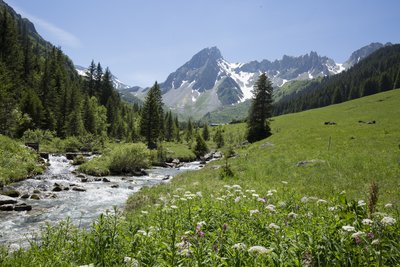
Alpage de la Rollaz - Geoffrey Garcel - CEN 74 
The mountain pasture
Alpine pastures are a landscape that have been shaped by humans since prehistoric times, during the Neolithic period, when livestock farming was first practised. Had it not been for the grazing of domestic animals at this altitude, the area would have been occupied by a few species of bush accompanied by few animal species. The mountain pasture is a rare example where human activity generates a biodiversity of animal and plant species that is more prolific than what would be produced by the natural evolution of the environment. Many species of plants, birds, invertebrates, mammals, etc. can be found here.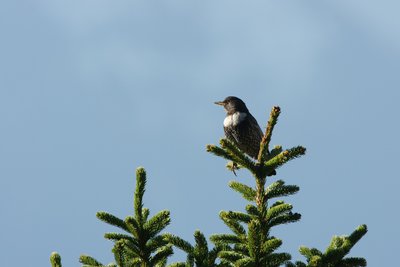
Merle à plastron perché - Julien Heuret - CEN 74  Fauna
FaunaThe Ring Ouzel
As its name suggests, the ring ouzel is similar in size to the blackbird and belongs to the same genus according to the classification of living organisms. It is a mountain species, found only in the Alps. It nests in the "combat zone", i.e. the transition zone between the subalpine (forest) and alpine (grassland) levels, where there are fewer trees that are reminiscent of bonsai trees with their stunted silhouettes. The Ring Ouzel can be recognised by the white flap on its chest.
Description
From the car park, take the "la Gorge" ski lift to the "Signal" arrival station, the starting point for the hike: Take the path on your right towards the "Chalets de Roselette". Take the path on the right. At the crossroads, take the path on the right that climbs towards "Les prés". At "Chalet des prés", take the path that climbs to your right. Continue along the country road heading downhill.
- Departure : "Le Signal" terminal station, les Contamines-Montjoie
- Arrival : Le Signal station, les Contamines-Montjoie
- Towns crossed : Les Contamines-Montjoie
Altimetric profile
Sensitive areas
Along your trek, you will go through sensitive areas related to the presence of a specific species or environment. In these areas, an appropriate behaviour allows to contribute to their preservation. For detailed information, specific forms are accessible for each area.
- Impacted practices:
- Aerial, , Land, Vertical
- Contact:
- Asters - Conservatoire d'espaces naturels de Haute-Savoie
contact@cen-haute-savoie.org
Black grouse - winter
- Impacted practices:
- , Land
- Sensitivity periods:
- JanFebMarAprDec
- Contact:
Black grouse - winter
- Impacted practices:
- , Land
- Sensitivity periods:
- JanFebMarAprDec
- Contact:
Recommandations
Always exercise caution and plan ahead when hiking. Asters, CEN 74 cannot be held responsible for any accident or incident that may occur on this trail.
Transport
Bus shuttles depart from Les Contamines-Montjoie village centre (from late June to early September).
Access and parking
Drive through the village of Les Contamines-Montjoie (74170) and stay on the Route de Notre Dame de la Gorge (D902) for 1.5 kilometres until you reach the ski lift departure point for "la Gorge". Park in the large cable car park on your left. Take the cable car to the "Signal".
Parking :
Ski lift parking "La Gorge"
Accessibility
- Emergency number :
- 114
Report a problem or an error
If you have found an error on this page or if you have noticed any problems during your hike, please report them to us here:
